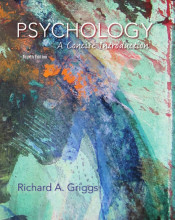Dissociative disorders and somatic symptom-related disorders
25 important questions on Dissociative disorders and somatic symptom-related disorders
Which major dissociative disorders are there?
- depersonalization/derealization disorder
- dissociative amnesia
- dissociative identity disorder
What are the DSM 5 criteria for depersonalization/derealization disorder?
- depersonalization;
- experiences of detachment from one's mental processes or body as if one's in a dream
- derealization;
- experiences of unreality of surroundings
- symptoms are persistent or recurrent
- reality testing remains intact
- symptoms are not explained by substances, or other disorders or medical conditions.
What are the DSM 5 characteristics of dissociative amnesia?
- inability to remember important autobiographical information, usually of traumatic or stressful nature, that is too extensive to be ordinary forgetfulness.
- the amnesia is not explained by substances or by other medical or psychological conditions
- Higher grades + faster learning
- Never study anything twice
- 100% sure, 100% understanding
What criteria is added to the characteristics of dissociative amnesia to make the disorder classify as dissociative fugue?
- if amnesia is associated with bewildered or apparently purposeful wandering.
What are the DSM 5 criteria for Dissociative identity disorder?
- disruption of identity characterized by two or more distinct personality states (alters), or an experience of possession. disruptions lead to discontinuity in the sense of self or agency of the self.
- recurrent gaps in memory for events or important personal information that are beyond ordinal forgetting
- symptoms are not part of a broadly accepted cultural or religious practice
- symptoms are not due to drugs, or a medical condition
Which two theories about DID have arise?
- posttraumatic model
- sociocognitive model
Describe the posttraumatic model of DID
- some people are particularly likely to use dissociation to cope with trauma, key factor in causing the development of alters after trauma.
- children who are abused are at risk of developing dissociative symptoms
- children who dissociate are more likely to develop psychological symptoms after trauma.
How do we call something created within treatment?
Describe the sociocognitive model for DID
- people who have been abused seek explanations for their symptoms and distress, alters appear in response to suggestions by therapists, exposure to media reports of DID, or other cultural influences
- DID could be iatrogenic in that the person often learns to role-play these symptoms within treatment.
What kinds of evidence is there for the sociocognitive model?
- DID symptoms can be role played
- some patients can perform on memory tests with stimuli learned as other alters. while DID has the defining feature that alters do not share memories.
How do we call disorders that are defined by excessive concerns about physical symptoms or health?
What are the dsm 5 criteria for somatic symptom disorder?
- at least one somatic symptom that is distressing or disrupts daily life
- excessive thought, distress, and behavior related to somatic symptoms or health concerns indicated by at least one of the following;
- healt related anxiety
- disproportionate and persistent concerns about the seriousness of symptoms
- excessive time and energy devoted to health concerns
- duration of at least 6 months
What are the dsm 5 criteria for illness anxiety disorder?
- preoccupation with and high level of anxiety about having or acquiring a serious disease
- excessive illness behavior
- no more than mild somatic symptoms are present
- not explained by other psychological disorders
- preoccupation lasts at least 6 months
What is the key factor of conversion disorder?
- person suddenly develops neurological symptoms such as blindness, seizures, or paralysis.
- symptoms suggest an illness related to neurological damage, but medical tests indicate that the bodily organs and nervous system are fine.
What are the dsm 5 criteria for conversion disorder?
- one or more symptoms affecting voluntary motor or sensory function
- the symptoms are incompatible with recognized medical disorder
- symptoms cause significant distress or functional impairment or warrant medical evaluation.
What are the neurobiological factors that cause somatic symptoms disorders?
- models focus on brain regions activated by unpleasant body sensations
- unpleasant physical sensations increase activity in the anterior insula ad anterior cingulate cortex
- AI and ACC have strong connections with the somatosensory cortex.
- heightened activity in these regions is related to greater propensity for somatic symptoms and more intense pain ratings.
- pain and somatic symptoms can also be increased by anxiety, depression, and stress hormones
Describe the model of cognitive behavioral factors that increase awareness and distress over somatic symptoms.
- medical symptoms create physiological disturbance
- psychiatric disorder, stress, and trauma influence emotional arousal
- physiological disturbance and emotional arousal, influence each other and heighten attention to body
- attention to body saliences symptoms attributed to serious illness
- these experienced symptoms create health anxiety, and worries about serious illness
- these worries and anxiety cause help seeking and communication of distress, or avoidance and disability. also cause more emotional arousal
- communication and avoidance influences the social response
- this social response influences avoidance and emotional arousal
What are the cognitive factors of people with somatic disorders?
- people with excessive distress about somatic symptoms may automatically focus on cues of physical health problems
- people prone to worry about their health also tend to interpret their physical symptoms in the worst possible way
- the tendency to become overly concerned about one's health may have evolved from early experiences of medical symptoms or from family attitudes to physical illness.
What are the behavior consequences of fear that a bodily sensation signifies illness?
- person may assume the role of being sick and avoid work, exercise, and social tasks. these avoidant behaviors in turn can intensify symptoms by limiting other healthy behaviors
- the person may seek reassurance from doctors and from family members, this help-seeking behavior may be reinforced if it results in the person getting attention or sympathy
What are the psychodynamic perspectives on conversion disorder?
- theory suggest that the physical symptom is a response to an unconscious psychological conflict
- theory is based on case studies with conversion disorder unexplained blindness;
- might involve two processes;
- unconscious processing of perceptual stimuli
- motivation to be symptomatic
What are the dsm 5 criteria for factitious disorder?
- fabrication or induction of physical or psychological symptoms, injury, or disease
- deceptive behavior is present in the absence of obvious external rewards
- in factitious disorder imposed on self, the person presents himself to others as ill, impaired, or injured
- in factitious disorder imposed on another, the person fabricates or induces symptoms in another person and then presents that person to others as ill, impaired, or injured
What are reasons to believe social and cultural factors are present in conversion disorder?
- symptoms of conversion disorder are more common among people from rural areas and people of lower socioeconomic status.
- also it is known that mass hysteria can occur, in which a group of people with close contact develop conversion disorder.
How can inventions in primary care help treatment of somatic symptom and related disorders?
- people with somatic symptom-related disorders will seek treatment through general practitioners; teach them to tailor care for people with these disorders. establish strong doctor-patient relationship, patients sense of trust and comfort will make them reassured about their health
- informing physicians when a patient appears to be an intensive user of health care so they can minimize the use of diagnostic tests and medication; reduces use of costly health care services.
Describe cognitive behavioral treatment for people with somatic symptom-related disorders
- identify and change the emotions that trigger somatic concerns; treating anxiety and depression reduces somatic symptoms
- change, and challenge cognitions regarding their somatic symptoms
- change their behaviors to stop playing the role of a sick person; help people resume healthy activities and rebuild a lifestyle damaged by focus on illness-relate concerns
- family therapy; teach family members about operant conditioning to reduce amount of attention they give to the person's symptoms.
Next to cbt what are other treatments for somatic symptom-related disorders?
- hypnosis; reduces pain levels and influences brain regions involved in experiencing and interpreting pain
- acceptance and commitment therapy; therapist encourages client to adopt a more acceptant attitude toward pair, suffering, and moments of depression and anxiety and view them as natural part of life.
- anitdepressants
The question on the page originate from the summary of the following study material:
- A unique study and practice tool
- Never study anything twice again
- Get the grades you hope for
- 100% sure, 100% understanding
































